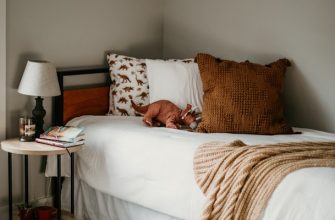Understanding the Importance of Sleep Environment
Creating the perfect sleep environment is essential for achieving restful and restorative sleep. A well-optimized atmosphere can significantly enhance the quality of sleep and improve overall focus during waking hours. Factors such as lighting, temperature, and noise levels play a crucial role in establishing a conducive environment for sleep.
Lighting is one of the most important elements to consider when designing a sleep-friendly space. Dim, warm lights signal the brain that it’s time to wind down, while bright, harsh lights can disrupt the body’s natural sleep-wake cycle. Using blackout curtains can help eliminate external light sources, thus promoting deeper sleep.
Temperature control is another vital aspect of a productive sleep environment. The ideal room temperature for sleep typically ranges between 60 to 67 degrees Fahrenheit (15 to 20 degrees Celsius). Maintaining a cool sleeping area facilitates better sleep quality, as the body naturally cools down during the sleep cycle.
- Consider using a fan or air conditioner to regulate temperature.
- Invest in breathable bedding materials that help maintain a comfortable body temperature.
- Use layered bedding to adjust warmth according to personal preference.
Noise levels in the sleeping area can also greatly affect sleep quality. Excessive noise can lead to fragmented sleep, making it difficult to achieve the deep, restorative stages necessary for optimal concentration. Soundproofing the room or utilizing white noise machines can help mitigate disruptive sounds.
In addition to these factors, the overall organization and cleanliness of the sleep environment contribute to better sleep. A clutter-free and tidy room promotes relaxation and reduces distractions that could interfere with falling asleep.
By focusing on these aspects, creating the ideal sleep environment becomes achievable. A harmonious atmosphere allows individuals to not only enjoy restful sleep but also enhances cognitive function and productivity during the day.
Essential Elements for a Restful Night’s Sleep
Creating a restful environment is crucial for achieving a good night’s sleep. Essential elements play a significant role in shaping the atmosphere conducive to relaxation and focus. A well-designed sleep space can enhance overall well-being and productivity. To foster an ideal sleep environment, consider the following key components:
- Comfortable Bedding: Invest in a high-quality mattress and pillows that provide the right level of support. Soft, breathable sheets can further enhance comfort and promote restful sleep.
- Optimal Room Temperature: Maintain a cool room temperature, generally between 18-22°C (64-72°F), which is ideal for sleep and helps regulate body temperature.
- Lighting Control: Utilize blackout curtains to block out external light sources. Soft, warm lighting in the evening can signal to the body that it’s time to wind down.
- Noise Reduction: Minimize disruptive noises by using earplugs or white noise machines. Creating a quiet space can significantly improve sleep quality.
- Aromatherapy: Incorporate calming scents, such as lavender or chamomile, through essential oils or candles. Aromatherapy can have a profound effect on relaxation and sleep onset.
- Decluttered Space: Keep the bedroom tidy and free from distractions. A clutter-free environment promotes tranquility and helps maintain focus.
- Consistent Routine: Establishing a regular sleep schedule can help train the body to fall asleep and wake up at the same time each day, enhancing the overall quality of sleep.
By integrating these essential elements, the atmosphere for restful sleep can be significantly improved. A combination of comfort, tranquility, and routine fosters an environment that not only supports sleep but also enhances productivity during waking hours. Prioritizing these factors can lead to a more restful night and a more focused day ahead.
Tips for Reducing Distractions in Your Bedroom
Creating a serene environment in the bedroom is essential for promoting restful sleep and enhancing concentration. Reducing distractions is a crucial step in achieving this goal. By implementing simple strategies, the bedroom can transform into a sanctuary of peace and focus.
- Limit electronic devices: Keeping smartphones, tablets, and laptops out of the bedroom can significantly reduce distractions. The blue light emitted by screens can interfere with sleep patterns and hinder the ability to concentrate.
- Establish a calming color palette: Opt for soothing colors such as soft blues, greens, or neutral tones. These colors create a tranquil atmosphere, conducive to relaxation and focus.
- Optimize lighting: Use dimmable lights or soft bedside lamps to adjust the brightness according to the time of day. Soft lighting is less distracting and promotes a restful environment.
- Declutter the space: A tidy bedroom can significantly enhance focus. Keeping surfaces organized and free of unnecessary items fosters a sense of calm and minimizes distractions.
- Incorporate soundproofing: Consider using heavy curtains or soundproof panels to minimize outside noise. A quiet environment is essential for quality sleep and maintaining concentration.
Implementing these strategies will help create an optimal atmosphere for productive sleep and improved focus. By prioritizing a distraction-free bedroom, individuals can enhance their overall well-being and daily performance.
The Role of Lighting in Sleep Quality and Focus
Lighting plays a crucial role in influencing both sleep quality and focus. The right lighting can create an ambiance that promotes relaxation, making it easier to fall asleep, while also enhancing concentration during work or study sessions. Understanding the impact of various light sources is essential for cultivating an environment conducive to restful sleep and heightened productivity.
- Natural Light: Exposure to natural light during the day helps regulate the body’s circadian rhythm, which is vital for quality sleep. Morning sunlight boosts mood and alertness, setting the stage for a productive day.
- Warm Lighting: In the evening, warm lighting is recommended. Soft, warm hues signal the body to wind down, preparing it for restful sleep. This type of lighting minimizes blue light exposure, which can interfere with melatonin production.
- Task Lighting: For tasks that require focus, such as reading or working, brighter task lighting is beneficial. It reduces eye strain and enhances concentration, enabling longer periods of productivity.
- Dim Lighting: Dim lighting in the bedroom promotes relaxation and signals it’s time to sleep. Using dimmable lamps can help gradually lower light levels, facilitating a smooth transition to sleep.
- Color Temperature: The color temperature of lighting influences mood and alertness. Cooler light temperatures during the day can enhance focus, while warmer temperatures in the evening promote a calming atmosphere conducive to sleep.
In summary, the interplay between lighting and sleep quality, as well as focus, is significant. By strategically utilizing natural, warm, and task lighting, individuals can create an ideal environment that fosters both restorative sleep and enhanced concentration. Making these adjustments can lead to a more balanced and productive lifestyle.
Creating a Calming Pre-Sleep Routine
Creating a calming pre-sleep routine is essential for establishing an ideal atmosphere conducive to restful sleep and enhanced focus. A well-structured nightly routine can significantly improve sleep quality, helping to prepare both the mind and body for a peaceful night. Incorporating specific activities into the pre-sleep routine can foster relaxation and signal to the body that it is time to wind down.
- Dim the Lights: Reducing light exposure in the evening helps to regulate the body’s internal clock. Soft, warm lighting creates a tranquil environment, making it easier to unwind.
- Engage in Relaxing Activities: Practicing gentle yoga, meditation, or reading a book can help calm the mind. These activities promote relaxation and can be an integral part of a soothing pre-sleep routine.
- Aromatherapy: Utilizing calming scents, such as lavender or chamomile, can enhance the sleep atmosphere. Essential oils can be diffused in the bedroom or applied topically to aid in relaxation.
- Limit Screen Time: Reducing exposure to screens at least one hour before bed helps to minimize blue light interference. This step is crucial in preparing the brain for sleep.
- Establish a Sleep Schedule: Going to bed and waking up at the same time daily supports the body’s natural rhythms. Consistency in sleep patterns is vital for achieving restorative sleep.
Incorporating these elements into a nightly routine can create an ideal atmosphere for sleep. By making conscious choices and prioritizing relaxation, individuals can enhance their overall sleep quality and focus during the day. A calming pre-sleep routine not only aids in falling asleep faster but also contributes to waking up feeling refreshed and energized.
How to Optimize Your Space for Better Concentration
Creating an optimal environment for enhanced concentration involves several key elements. The right atmosphere can significantly impact productivity and focus during work or study sessions. To begin with, consider the lighting of the space. Natural light is ideal for fostering a productive mindset, so positioning the workspace near a window can be beneficial. If natural light is limited, opt for soft, warm artificial lighting to prevent eye strain and maintain comfort.
- Declutter the Space: A tidy environment promotes mental clarity. Remove unnecessary items from the workspace to minimize distractions.
- Choose Comfortable Furniture: Ergonomic chairs and desks can enhance comfort, which is crucial for sustained concentration.
- Control Noise Levels: Use noise-canceling headphones or play soft background music to drown out disruptive sounds.
- Incorporate Plants: Indoor plants not only improve air quality but also create a calming atmosphere that can enhance focus.
- Maintain a Comfortable Temperature: A well-ventilated and temperature-controlled room can significantly improve concentration levels.
Additionally, consider implementing a routine that aligns with the desired productivity goals. Establishing specific time blocks for work or study can help reinforce a focused mindset. During breaks, stepping away from the workspace for a few moments can help reset concentration levels.
Finally, personalizing the space can also play a vital role. Adding elements that inspire creativity and motivation, such as artwork or motivational quotes, can create a more engaging environment. Overall, optimizing the space for better concentration involves a combination of strategic organization, comfort, and personalization to foster an atmosphere conducive to productivity.








